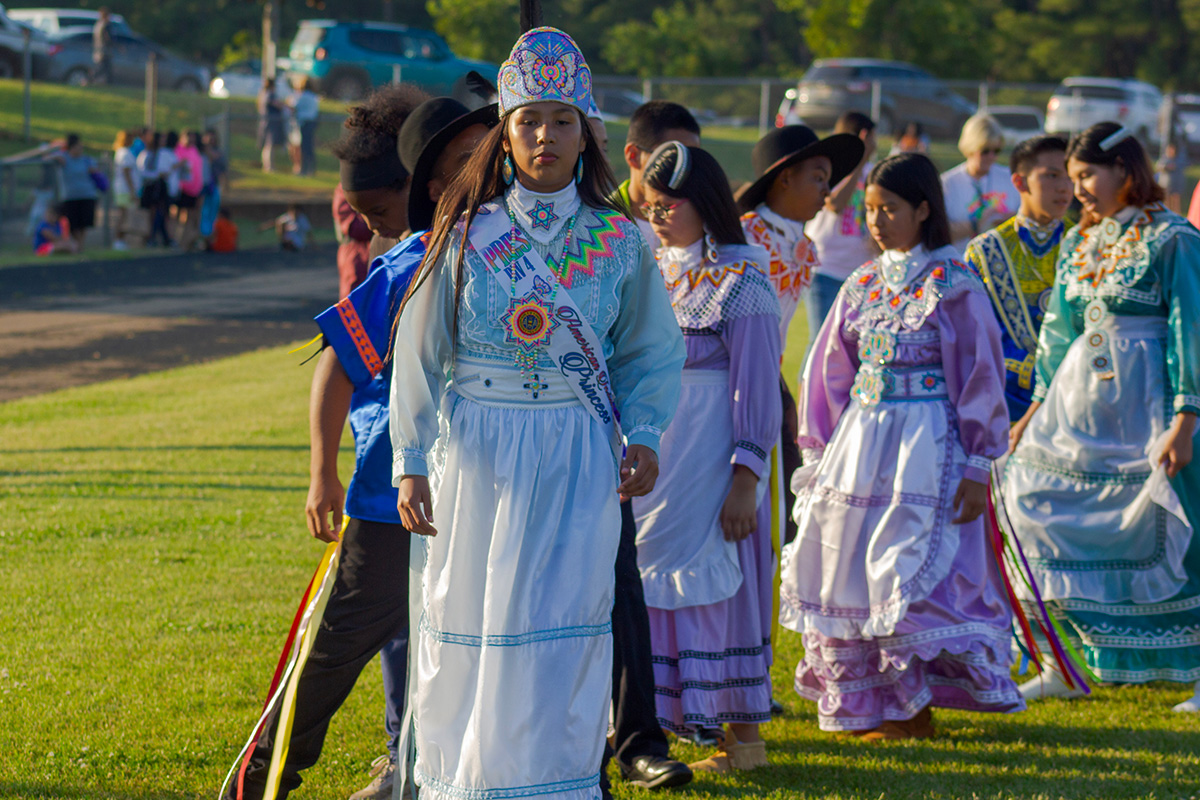As family and friends filled the stands at Choctaw Central High School’s football field on the evening of Tuesday, May 10, students from pre-kindergarten to sixth grade lined up with their teachers on one side of the track. Some were dressed in traditional Choctaw clothing—girls wearing pink, purple, blue or yellow dresses, boys wearing red, orange, and green shirts and black pants.
In the center of the field, a colorful banner facing the audience read, “Bihhi Ayasha Toffapi Hilha,” a Choctaw phrase that roughly translates to “Pearl River Spring Festival” in English. Parents and school staff attending the event wear T-shirts with the same phrase embroidered on it in rainbow colors.
Pearl River Elementary School organizes this yearly festival to celebrate the spring season, as well as the end of the school year.
A few minutes after 5 p.m., the sound of beating drums began to reverberate through the field as the chanter sang “The Walk Dance.” The children trek across the field to the bleachers, the older classes leading the line, the younger students in tow.
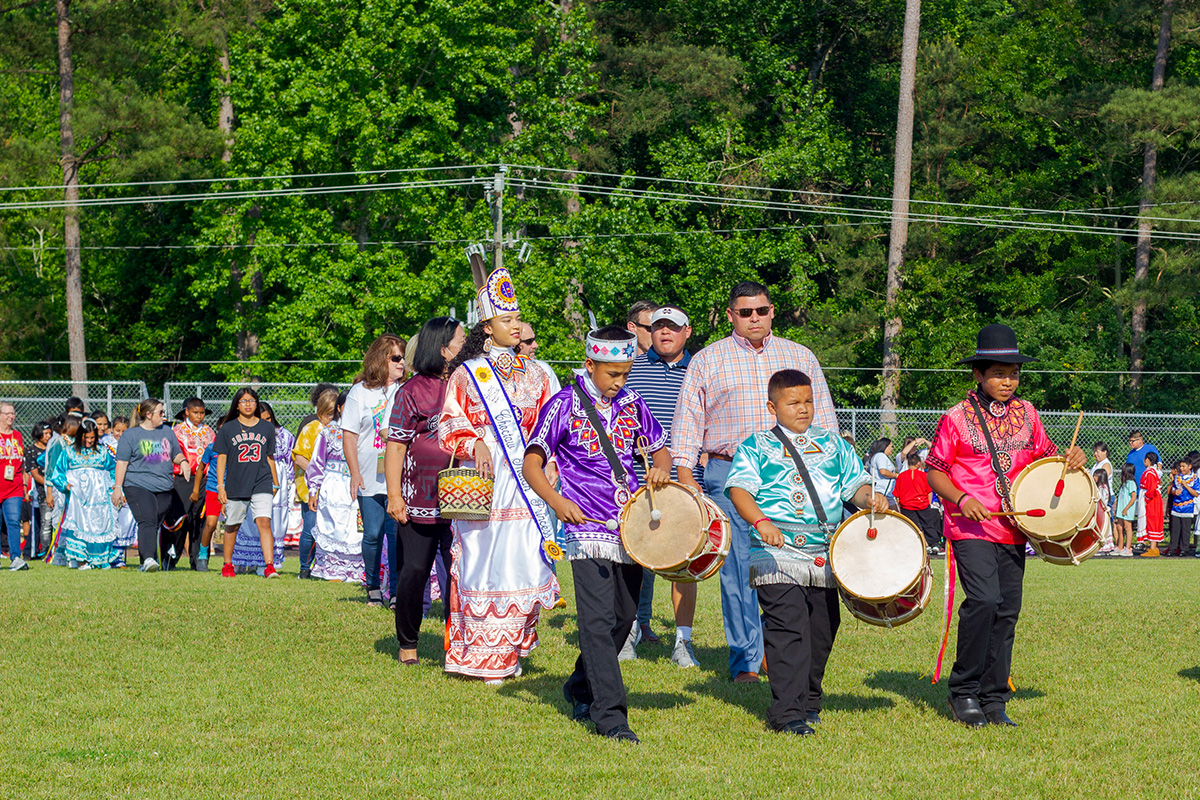
“During this song, you’ll see they take one step at a time as they go around the circle, but it’s supposedly the song that we sung when we were headed out to Trail of Tears,” Roger Amos, a Choctaw tribal member who also writes for the Mississippi Free Press, said at the event. “It’s supposed to be kind of a somber, sad song to see that we were leaving our homeland.”
Amos grew up in the Bogue Chitto community, one of eight Choctaw Indian communities and a part of the Choctaw Indian Reservation in Neshoba County. Pearl River is the presumptive capital of all the communities as it is the site of the Tribal Government Headquarters and has three tribal council representatives who are responsible for passing all the laws and regulations on the reservation.
“The max is usually three representatives on the tribal council, and most communities have two,” Amos said. “I know Pearl River and Bogue Chitto have three, so that tells you how big the reservations are.”
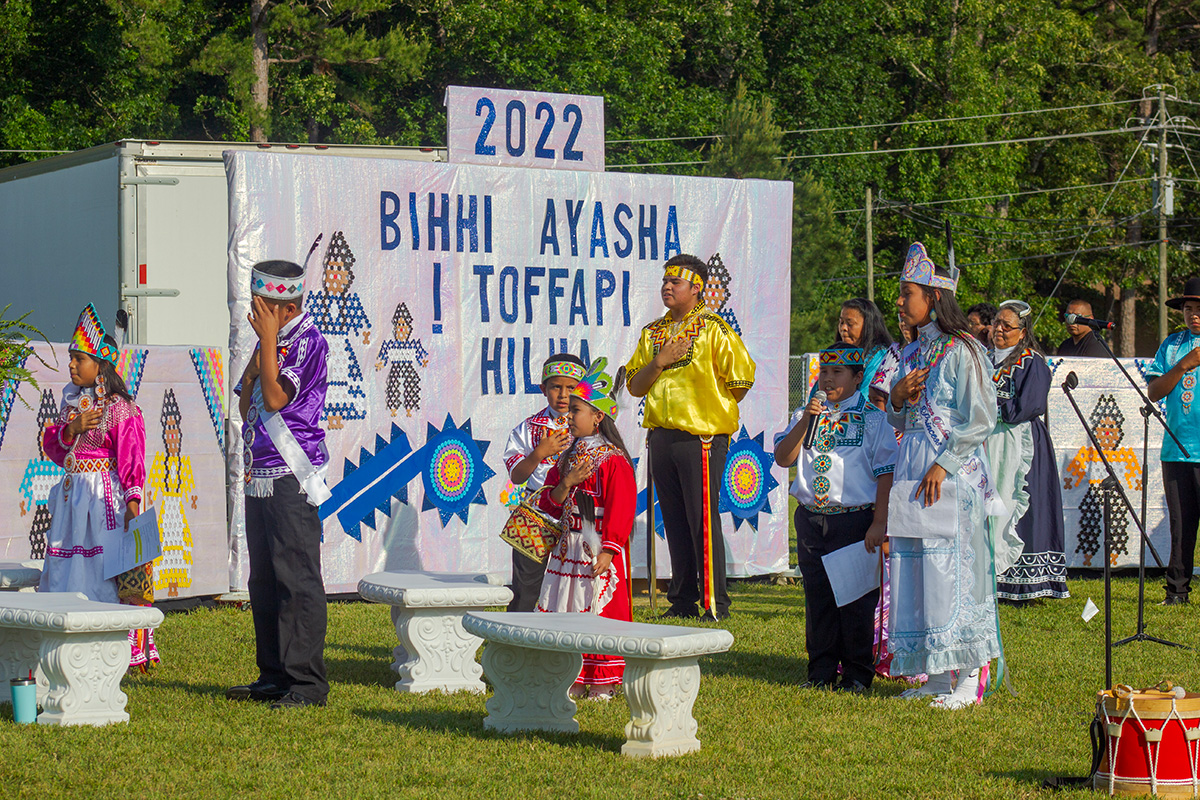
In 2020, usual organizers canceled the spring festival due to COVID concerns, and they held the program virtually in 2021. After two years since an in-person festival, Amos said it feels good to see the community come out and support the program and the students.
Once the song concludes, someone says a prayer, and then everyone stands for The Pledge of Allegiance and “The Star-Spangled Banner,” both of which Choctaw attendees recite in the tribe’s native language. Moments later, the pre-kindergarten classes move to the field to kick off the program.
‘Snake Dance, Duck Dance, Wedding Dance and Jump Dance’
The first pre-K class walks to the center of the field, which sports a white circle. The children each hold onto the arms of the person in front of them as they walk around the circle, following the leader, while singing “The Snake Dance” in tandem with the lead vocalist.
Suddenly, the song changes tempo.
“When the tune changes, the dance is supposed to go a little bit faster, and then they coil around a circle like a snake,” Amos explained. “It’s pretty much follow-the-leader. It’s up to whoever is in front to go however he wants with everybody else following, but it’s supposed to imitate the snake.”
The ringleader begins to move inward and out again, coiling the line like a snake, and the children follow suit, although some harmlessly bump into one another.
Next, the students prepare for “The Duck Dance,” where the dancers shuffle their feet in an imitation of how ducks traverse land.
“This one will also go in a circle,” Amos said. “There’s two dancers that will be face-to-face, and then when you hear the pitch of the chanter go up, two of the partners will raise their hands, and the other two will go under it, like ducks go underwater.”
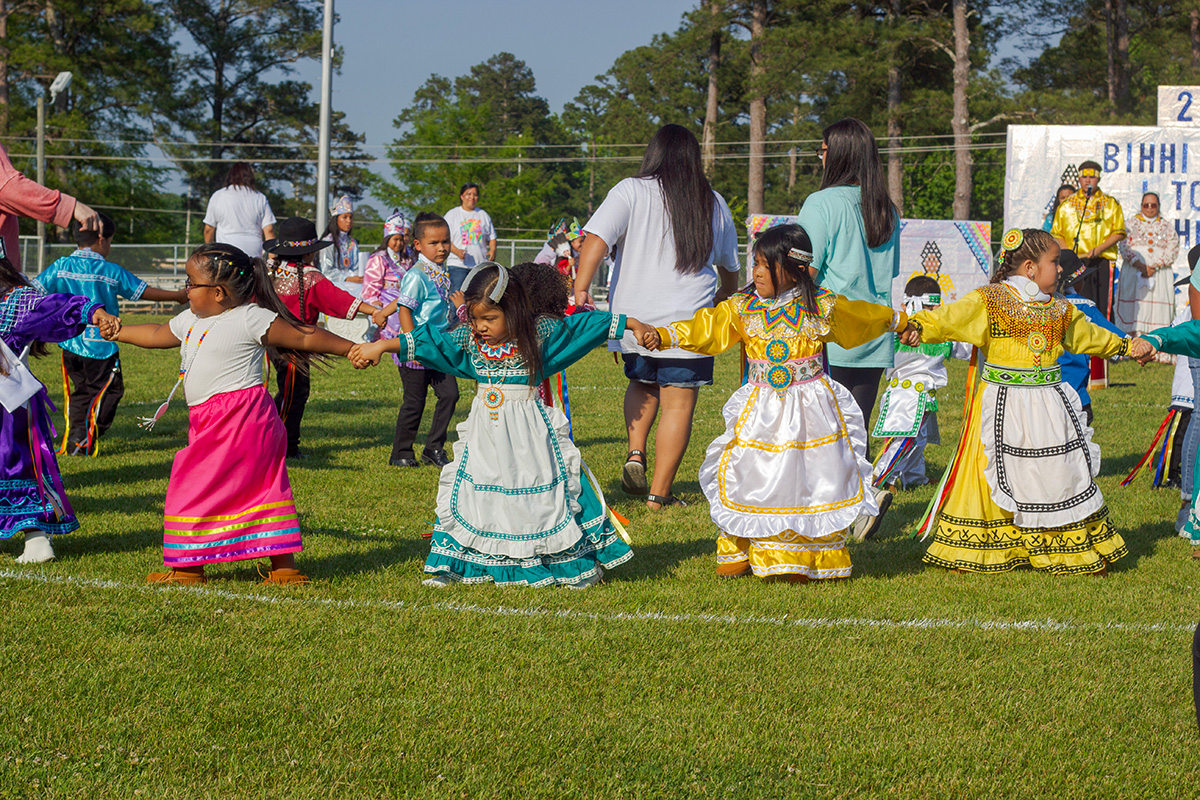
Two boys and two girls pair up together. As the chanter begins the song, the girls begin to shuffle their feet around the circle toward the boys, who lift their hands up together, as the girls pass through. While the boys stay in the place, the girl students keep moving around the circle until the chanter stops.
Choctaw dances are not for performance, but for participation. For years, the Choctaws danced for entertainment after community ball games and other events, but people do not hold competitions for Choctaw dances.
War dances, social dances and animal dances comprise the three types of Choctaw dances. Unlike in other tribes, women would join the men for the war dances performed to prepare for battle. Animal dances mirror the behavior of animals, and social dances mark important aspects in life like friendship, courtship and marriage.
Pre-kindergarten boys and girls now partner up by linking their pinky fingers as the chanter begins to sing “The Wedding Dance,” which is performed at traditional Choctaw weddings, where people from the same tribe or family are discouraged from dancing together. Once the chanter’s pitch changes, the partners switch places, one becoming the leader and the other, the follower.
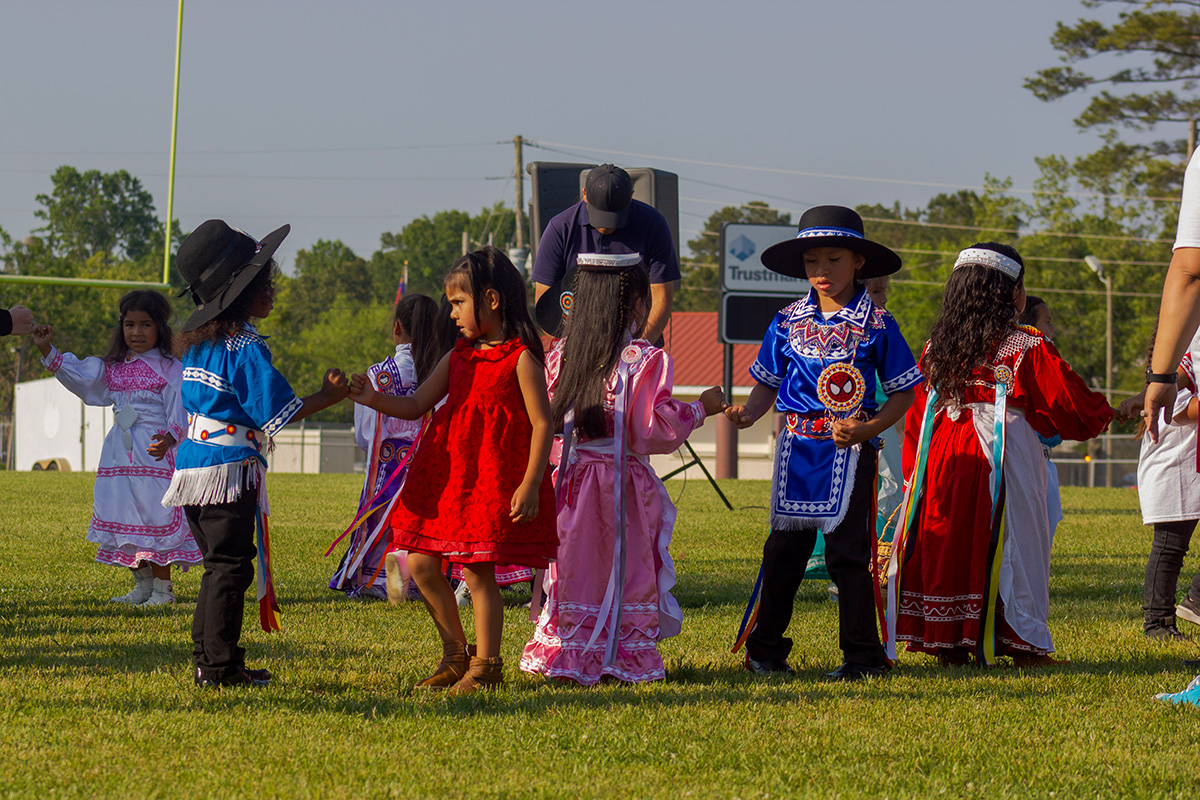
“Everybody connects by pinky like that and then everybody goes around the circle. When the chanter’s pitch changes, everybody switches, but they keep going the same direction,” Amos noted. “If you’re the one that’s got your back turned and you’re moving, you’re kind of depending on the person in front of you to lead you, but when the pitch goes up and you flip around, the roles are reversed.”
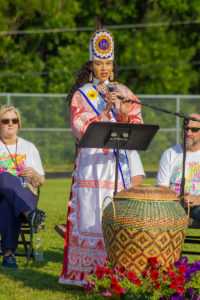
Once the pre-K students return to the stands, the kindergarten class takes the field, forming into two lines—one for boys and one for girls. The chanter begins, and the children jump together around the circle. This display, “The Jump Dance,” was often danced in the past when a good crop was harvested, although it was also used during other times of celebration as an expression of joy.
‘Friendship Dance, Raccoon Dance, Stealing Partners Dance’
First-grade classes presented “The Friendship Dance,” a social dance that celebrates the close ties they share among one another. Once again, the children formed two lines facing each other, one for boys and one for girls.
When the song starts, both lines move side-to-side before the boys and girls join hands and shuffle around the circle. The changer changes his pitch, the line stops, and the first girl in line goes to the back—the process repeating as the rest of the girls slowly make their way to the front of the line.
Second graders performed an animal dance, “The Raccoon Dance,” and a social dance, “The Stealing Partners Dance.” Choctaw Native Americans traditionally used the fur from raccoons for clothing and hats. The dance imitates two raccoons chasing each other in play. The dance is a sign of respect for the raccoon.
The children formed a circle that was not quite closed, holding the arm of the person in front of them. Some boys enhanced the performance by wearing raccoon tails on the backs of their hats. As the chanter sang, the line moved in one direction two times before moving in the opposite direction twice.
Once the chanter repeated the chant for the third time, the circle stopped, and they dropped hands. The person in the front and back then chased each other through the group, touching each other like in a game of tag.
“The ones at the front and the end, once they’ve done their little chase scene, then they go to the middle—that way the next one in line (can go),” Amos explained.
The Stealing Partners Dance, a favorite among Choctaw people, allows each dancer to choose as many partners as they would like, including from members of the audience, whom they can “steal” to participate in the dance.
“Dances like this, the audience participates, but since there is nobody down there close by, the Chief Princess, she’s most likely the one that gets stolen,” Amos hypothesized before the song began. “The Chief also, so we’ll see how this turns out.”
The dance requires one line, boys in the front and girls in the back as they hold onto each other. The first boy in line moves to the back and steals a girl, bringing her to front with him as they continue to move around the circle.
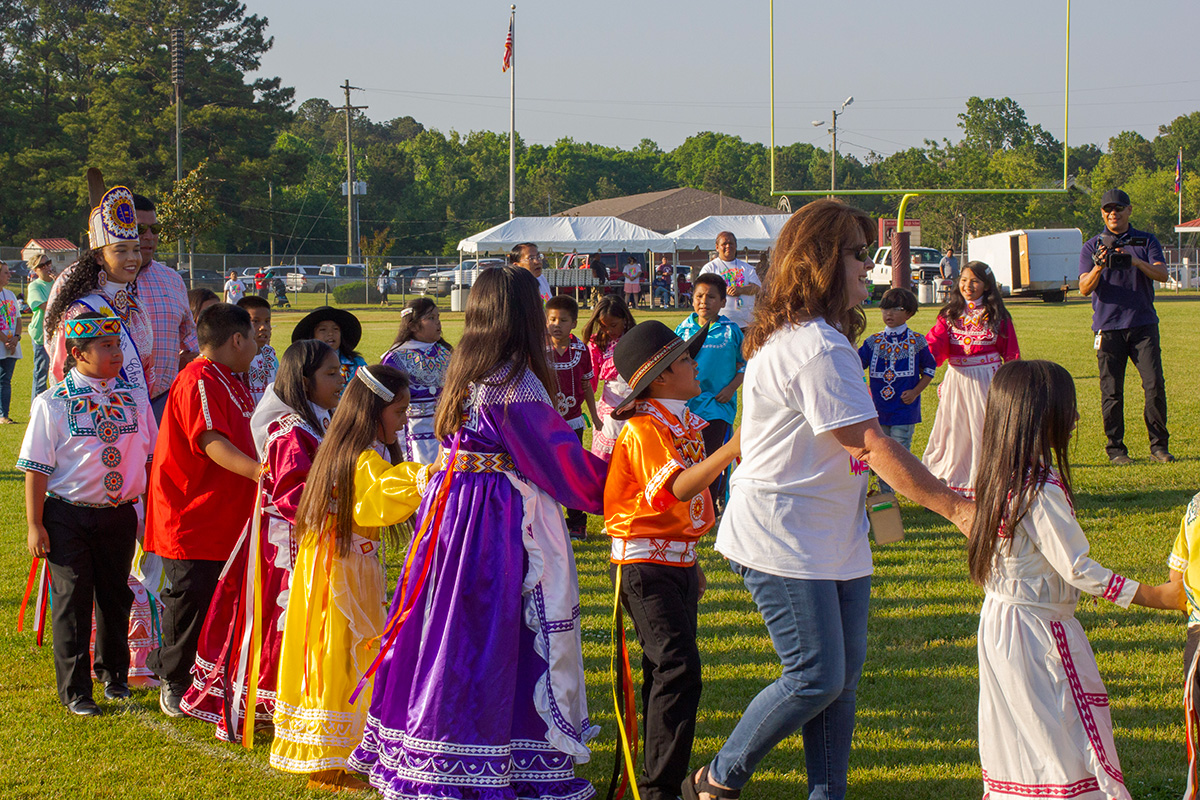
At one point, a little boy proved Amos right by going into the audience and stealing the Chief Princess. Chief Cyrus Ben is next to be pulled in, along with other staff members. At one point, another young man tried to steal the Chief Indian Princess Shemah Crosby, but the Chief jokingly stopped him.
“You can tell a lot of the instructions come from the chanter,” Amos said. “You listen to know what to do.”Girls may also steal partners during this dance, and the participating second-grade girls do just that, adding to the fun and mayhem that ensued as the chant continued on. The circles got bigger and bigger, but once the chanter’s pitch changed, everyone joined hands to hop around the circle before changing directions until the chant stopped.
‘Quail Dance’
Third graders performed “The Quail Dance” in honor of an animal the Choctaw admired for its ability to blend into its environment to escape its enemies. An effective strategy, Choctaw people used this method as a surprise during times of war and conflict.
For this dance, boys and girls lined up, facing each other. The chanter began, and they shuffled their feet toward their partner about 10 times. Afterward, they joined hands and shuffled around the circle. This dance requires a prop, a handkerchief, which the male partner held in his hand and fanned upward as they moved around the circle.
“The handkerchief is like scaring off the quail,” Gail Thompson, Roger Amos’ aunt, explained.
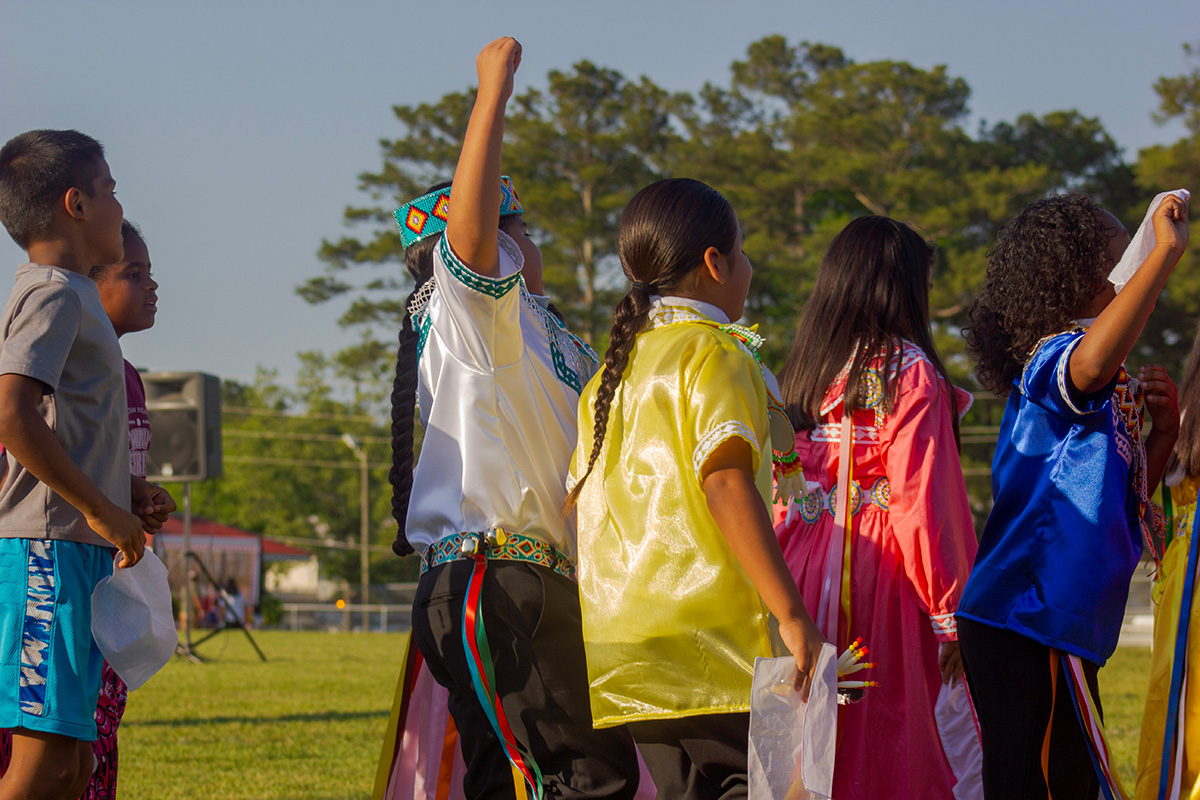
Thompson had a granddaughter and two grandsons participating in the festival. Her granddaughter, a fourth grader, chose the color of her attire that evening, a pink dress with rainbow stripes around the bottom.
The grandmother said some kids choose the color or design of their dresses, while others let their parents choose for them.
“My granddaughter likes (unicorns),” Thompson said. “I asked my great-niece to make it for her, so she finished it. That’s what she’s wearing tonight.”
Dresses that Choctaw women wear are handmade and adapted from the 19th-century dress design, a bodice with a fitted waist and a long, full skirt trimmed with ruffles and hand-sewn applique. A white apron, trimmed in the color of the dress, also accompanies the outfit, The Mississippi Band of Choctaw Indians reported.
Men’s shirts are designed with either a round neckline or an open collar, and the applique work on the front and sleeves is made the same way.
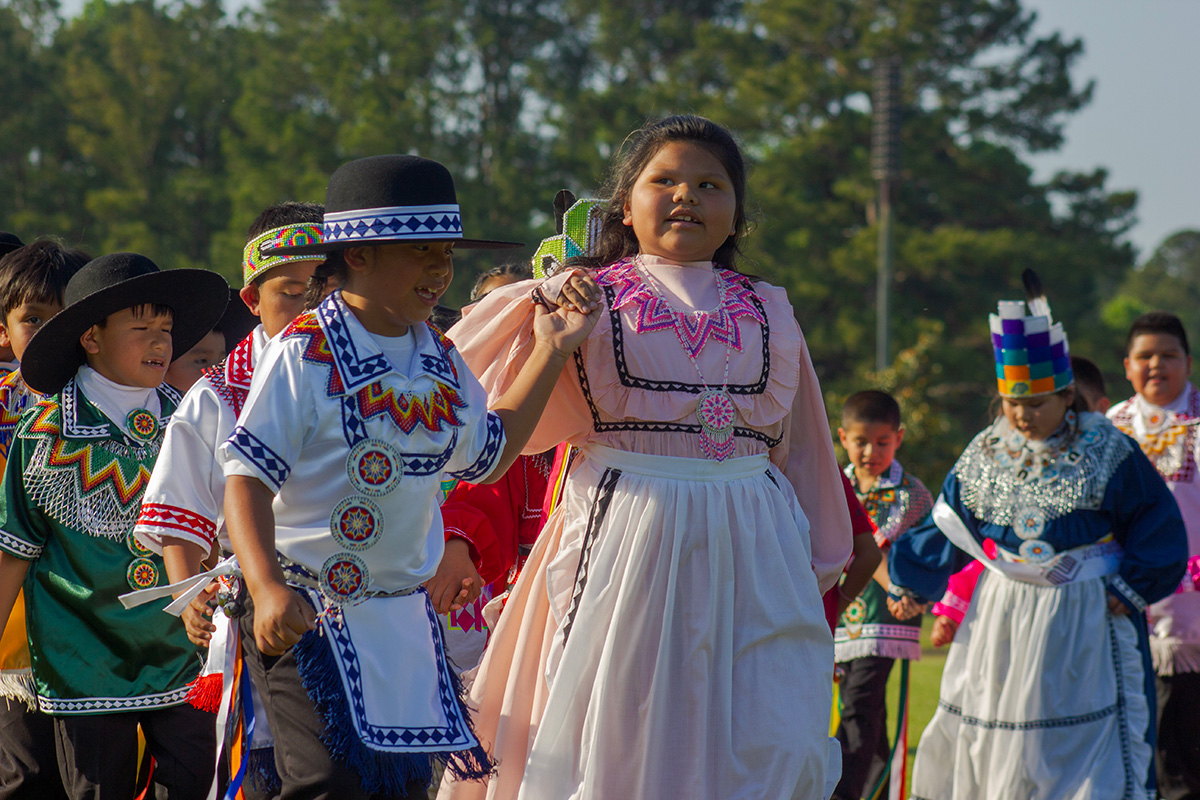
Choctaw seamstresses usually trim dresses with one of three motifs: full diamond, half diamond or a series of circles, and crosses that represent stickball and stickball sticks. Stickball is a game where teams use handcrafted sticks, kabocca, and a woven leather ball, towa. Each team tries to get the ball to the other team’s goal post using their sticks, never touching or throwing the ball with their hands.
“Some have the diamond design, meaning the rattlesnake,” Thompson told the Mississippi Free Press.
The diamondback rattlesnake design often adorns Choctaw baskets as well. Men and women wear decorative beadwork on traditional clothes with design and color at the artist’s preference. A beadwork set for women includes a belt, medallion, collar necklaces, earrings, ribbon lapel pins, a handkerchief lapel pin and a round comb.
“If I get (clothes) made, I usually keep them because I might have other grandkids to come along to wear it,” the grandmother said.
Most Choctaws today wear Choctaw dresses and shirts for special occasions. The fabric is cotton in solid colors with a contrasting trim. Women choose silk or velvet fabric for traditional dresses, usually for an event like the Choctaw Indian Princess Pageant, which happens at the annual Choctaw Fair, this year July 13-16.
‘War Dance, Stickball Dance, Walk Dance’
Fourth graders performed “The Four-Step War Dance,” one of the few chants that uses actual Choctaw words to give the dancers directions. Two lines formed and shuffled around the circle as the chanter sang.
When his pitch changed, the two lines turned to face each other, kicking one foot toward their partner and then replacing it to kick out the other foot. Dancers performed this motion four times before the circle returned back to step one, shuffling around the circle.
Thompson’s granddaughter was in this group, wearing a crown and a black shirt over her pink dress. “That’s the hardest thing for me to do,” Thompson said of the dance.
Fifth graders performed “The Stickball Dance,” representing one of the oldest traditional sports the Choctaw played. When conflict would rise between communities, the game was used as a peaceful way to settle issues.
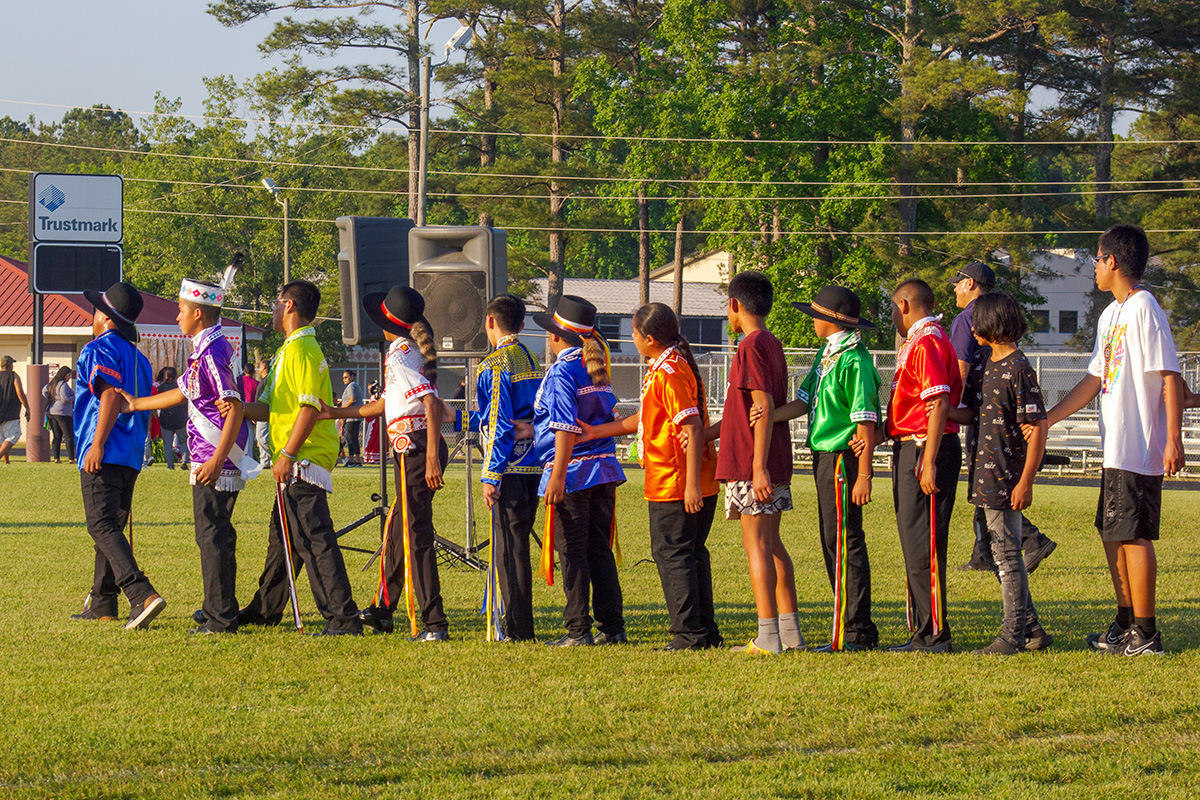
Girls and boys partnered up in two lines. Once the chanter began, the lines walked around the circle. Then, as the tune changed, the lines shuffled one foot toward their partner and then kicked out the other foot as they moved around the circle.
Sixth graders performed “The Mosquito Dance,” which allowed dancers to copy the pattern of the mosquito while in flight. Girls and boys formed two lines beside each other, and after the chanter began singing, the duos shuffled from foot to foot.
Again, the chanter’s pitch changed, and the boys crossed behind the back of the girls, landing on the opposite side. The girls went next, and both lines continued to take turns around the circle until the chanter stopped.
The closer and final dance of the night was “The Walk Dance” once more, and participants circled back to the festival’s entrance. Forming a singular line, students each held onto the arm of the person in front of them. When the chanter began, the line took only one step at a time, moving around the circle before eventually veering off the white line.
The line continued, one step at a time, until the chanter ended.
Following the conclusion to the festival’s songs and dance was a feast, one that attendees could take to-go. The meal consisted of traditionally grilled chicken, hominy, fry bread and green beans. Fry bread is a flat dough, pan-fried or deep-fried in oil, shortening or lard. It can be eaten alone or folded in a manner similar to a taco.
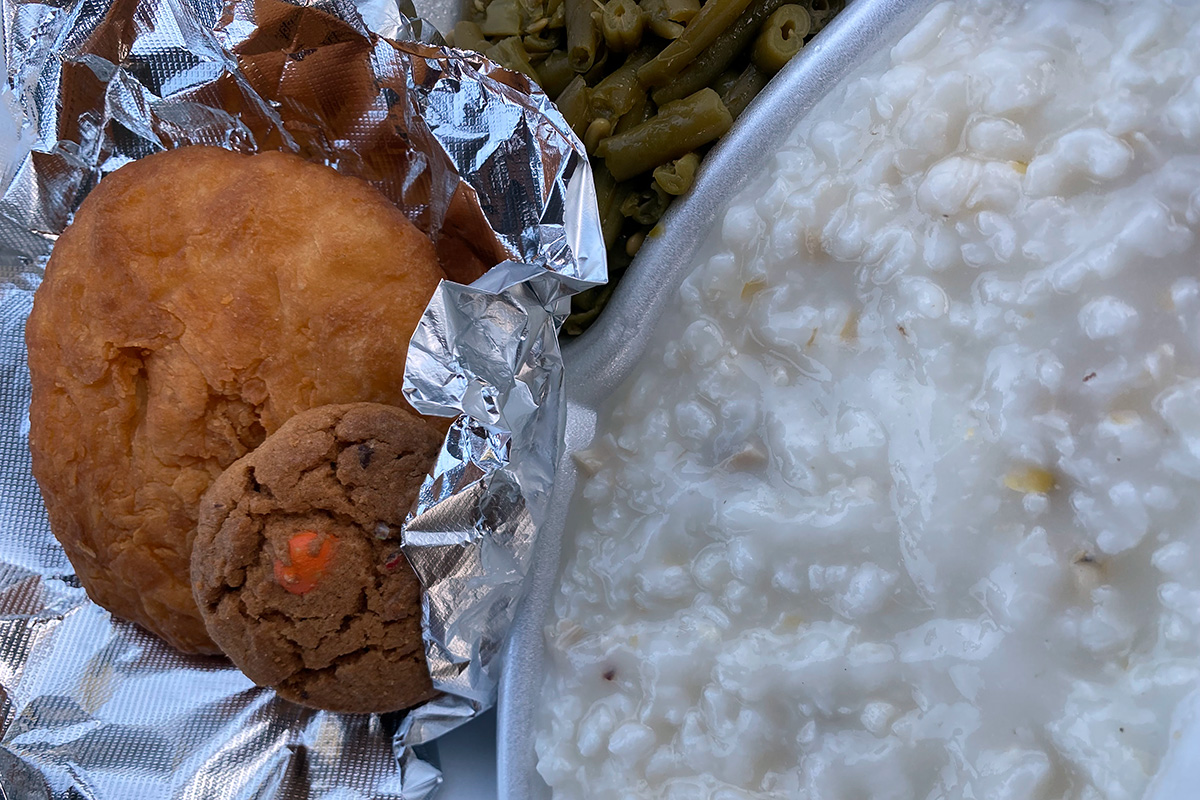
Hominy is made from corn dried in the husk. The kernels are removed from the cob and pounded in a kiti, a mortar made by burning a bowl-like indentation in a 3- or 4-foot section of a small tree trunk, which loosens the hulls on each kernel.
The corn is tossed in an open-ended basket called a fanner to loosen the hulls more. When the hulls are separated from the kernels, hominy is ready to cook.
To learn more about Pearl River and the Mississippi Band of Choctaw Indians, visit choctaw.org.

